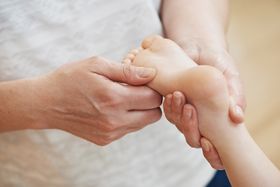Children With Knock Knees: When to Seek Medical Attention
Take a closer look at knock knees, including what causes them, treatment, and whether you should be worried if you or your child has them
Updated November 2, 2023.

Knock knees—also known as genu valgum—are common in children where the knees angle towards each other, resulting in a noticeable gap between the ankles.
While it often corrects itself as they mature, persistent knock knees beyond eight years old can indicate a more severe underlying issue. Understanding the signs and causes of this condition helps you ensure your kid's proper foot development by intervening on time.
Understanding Knock Knees
In kids with this condition, the knees angulate toward each other and touch when the feet are straightened. The lower leg points away from the centre of the body, resulting in a wide gap between the ankles.
Are Knock Knees Normal?
Knock knees are expected in children and should naturally correct between six and eight years old, as the legs straighten as your kid grows.
If the knock knees persist beyond eight years old, consult an orthopaedist.
» Find out if knock knees affect height growth
Causes and Symptoms
The typical causes of knock knees in children are:
- Bone diseases like Rickets and Blount's disease
- Genetic conditions like Achondroplasia, skeletal dysplasia, and joint hypermobility syndrome
- Injury to the growth plate in the shin or thighbone
- Obesity
Some of the most common knock knees symptoms are:
- Knee or hip pain
- Difficulty walking or running
- Joint stiffness
- Asymmetric leg appearance
- Unusual walking pattern
Identifying Knock Knees
To identify knock knees, you can observe your kid's standing posture to see if their knees are angled when standing with their legs straight and toes pointed forward.
Additionally, consult an orthopaedist if:
- The gap between the ankles is more than 8cm when your child stands with the knees together.
- One or both knees are painful and swollen.
- Only one leg is affected, or the legs are different lengths
- Your kid has difficulty moving or is in a lot of pain
Treatment Options: How to Fix Knock Knees
Diagnosis
When diagnosing knock knees, a doctor physically examines the child while standing and asks about the child's medical history.
They may also order a radiological investigation. The X-ray shows the angle between the thigh and shin bone, helping them assess the severity of the condition.
Treatments
The doctor may decide that your kid needs treatment for knock knees. They may recommend bracing for mild cases, or surgery to correct the deformity if it's too severe.
» Understand your baby's leg development
Knock Knees: Taking Steps Toward Healthy Growth
When it comes to knock knees, early identification and appropriate treatment are essential for your child's well-being and proper development.
While mild cases may naturally resolve with time and monitoring, more severe instances may require the use of braces or, in extreme cases, surgical intervention. Consult a doctor if you notice worsening symptoms, persistent pain, or significant movement difficulty.
If you want to ensure your kid's feet develop correctly, check out First Walkers orthopaedic shoes—designed to support the developing feet of toddlers as they learn to walk.





